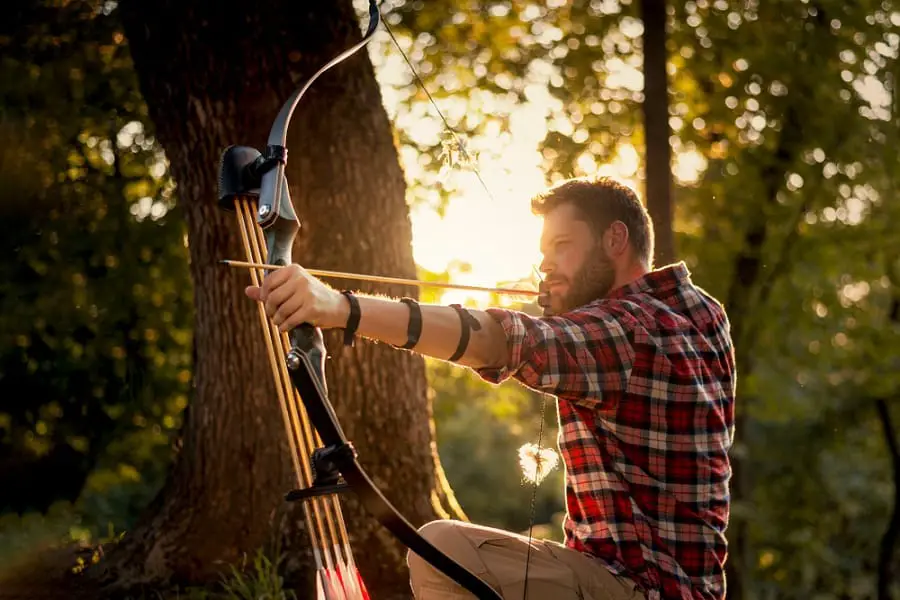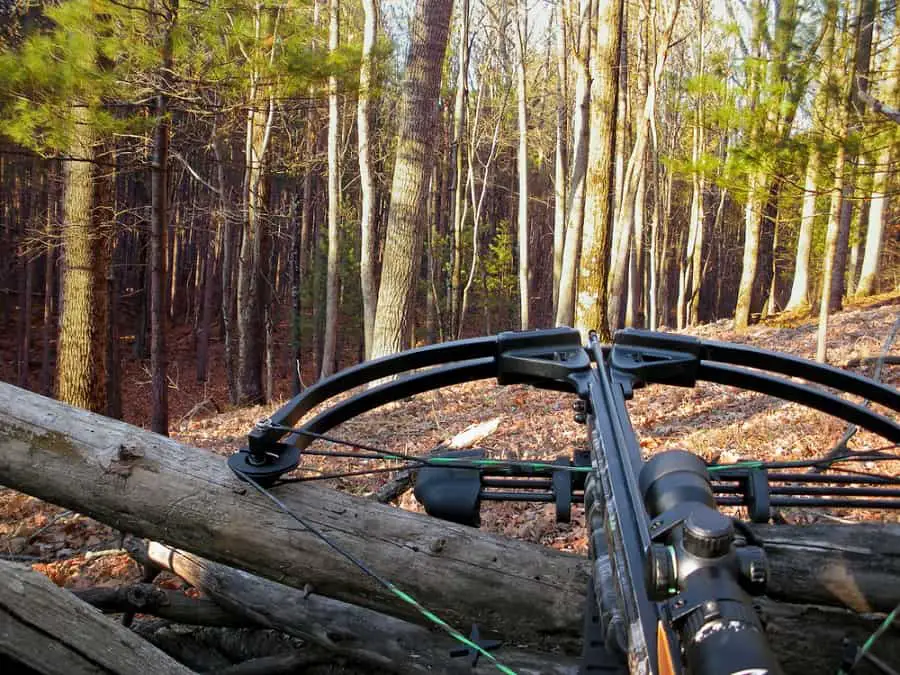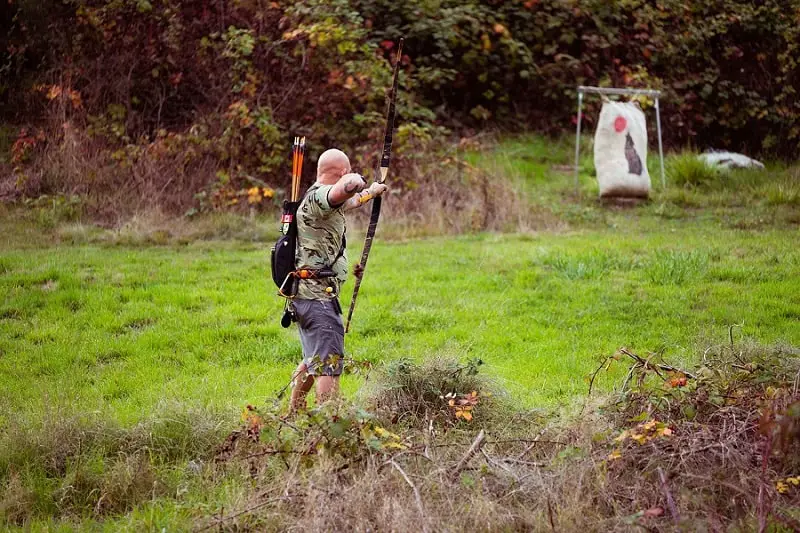
The bow: That ancient, primitive, and mysterious weapon that conjures up a feeling of hunting in a bygone era. It’s instinctual and meditative to shoot. There is an undeniable rush that comes with putting an arrow exactly where you intended. It’s a magical and addictive internal competition to recreate your form every time you draw and release an arrow downrange at your quarry.
Ted Nugent describes it as the “mystical flight of the arrow.” That pretty much nails it.
Then there’s the crossbow – also a primitive weapon of ancient times which eventually supplanted the bow and arrow. Part bow and part rifle, these things look wicked—like it could fill your tag plus five more with one shot. Modernized by evolving technology, it’s easier to learn than traditional bow shooting. The crossbow is gaining popularity in the field every year.
Here’s the question: Which one should you choose? Do you want to hunt deer like a 4th-century archer with a longbow? Or do you want a weapon that will completely “take the load off” at full-draw and flatten the learning curve? In that case, you should be thinking of a compound crossbow.
In this crossbow vs bow overview, we’ll talk about the different bow options, weigh the pros and cons, and discuss how that might align with your particular bowhunting needs.
Crossbow vs Bow: The Types
Every type of bow has something to offer. Although hunters can get passionate about their bow of choice, it depends on the hunting experience you are looking for.
Let’s break it down and define the basic weapon types within the broader crossbow and bow categories.
Bow
The word “bow” is all-encompassing, used to describe a category containing several styles of weapon. Let’s take a look at the different types. You’ll have a better understanding of each style.
Longbow
The original, iconic bow of Asian, European, and Native American cultures. The longbow is the most straightforward bows and features a single string and an “arrow shelf” that the arrow sits on when firing.
Historically, longbows were made from a single piece of yew wood. Over time, other wood species were used in the longbow’s construction. Techniques even include laminating multiple hardwood types into a single piece.
Recurve Bow
The traditional bow where the limbs curve away from the archer. The recurve design allows for a faster and slightly more compact bow than a traditional longbow.
The modern recurve is made from wood or synthetic composite materials. It has the capability to be fitted with sights and arrow rests. Most traditional archers tend to opt for “instinctive shooting” with these bows, rather than add modern sighting systems.
Compound Bow
The compound bow combines a somewhat traditional shape plus technology, to create an efficient, faster-shooting bow that doesn’t fatigue the hunter.
Incorporating cams, idle wheels, strings, and cables, the compound bow gives the shooter a mechanical advantage to pull back and hold a higher draw weight than a conventional bow.
Crossbow
Essentially, a normal bow turned on its side and affixed to a rifle-like stock or tiller. Crossbows rely on a cocking device to draw the string back, which locks into position, relieving the shooter from holding the draw weight. A trigger mechanism is then used to fire the bolt.
Recurve Crossbow
Just like the recurve bow, the recurve crossbow features limbs that curve away from the archer.
To give a long enough power stroke (which produces faster arrow speed), the limbs tend to be longer than the compound crossbow. Light and straightforward, the recurve is a truer traditional crossbow.
Compound Crossbow
As you may have guessed, the compound crossbow features cams and cables, giving the crossbow shooter a mechanical advantage. Like its compound bow cousin, the compound crossbow fires a bolt at a significantly higher velocity. Compact and powerful, the compound crossbow is the standard choice for big game hunters hunting with a crossbow.
Pistol Crossbow
Essentially, a mini-crossbow slapped on a pistol grip. These little guys are just plain fun. It is a very short-range weapon that is fired with one hand and is intended for small game. Depending on your state, the draw weight is typically enough to pass regulation for deer, but discretion should be exercised.
Vertical Bow
If you were to take a crossbow and keep the tiller as-is, but flip the limbs back into a normal bow position, you would have the vertical bow. A more recent innovation, these come in a pistol version as well. The vertical bow is oriented like a standard compound bow but with the features of a crossbow.

History of the Crossbow
The invention of the crossbow is generally credited to the Chinese before the 6th century BC. Its first recorded appearance as a weapon-of-war occurred in 341 BC, during the Battle of Ma Ling.
The ancient ranged weapon eventually eclipsed the use of traditional bows, due to its relative ease of use and training.
Traditional archery was considered a much more specialized skill, and archers were regarded as superior warriors. Beginning as a youth, an archer or bowman would be committed to a lifetime of training due to the precision needed and the hefty draw weight of bows of that time-period—upwards of 170 pounds.
With 0% let-off. Think of that the next time you’re trying to crank on a 70 or 75-pound compound bow!
By contrast, a crossbowman could be effective with a crossbow in a matter of days or weeks and still be able to pierce chainmail and armor with an accurately fired bolt.
Countries such as Greece, Rome, France, Spain, and others developed their own versions of crossbows between the 4th and 2nd century BC.
During the Medieval Period, crossbows didn’t come into play until the 10th century. However, some depictions indicate they may have been used for hunting up until then.
Crossbows kept evolving and ranged in size from large mounted units to the smaller hand-held crossbows. Even with increasing technology, such as the repeating crossbow, gastraphetes, and Scorpion Ballista – the use of the crossbow in warfare eventually waned. Apart from its use in hunting and special operations, by the 1500s, it had all but been replaced by gunpowder and early firearms.
Although crossbows had been constructed of composite materials of the day (wood, bone, metal, and sinew), today, crossbows are made from materials such as fiberglass and aluminum alloy.
Crossbows have significantly improved in their construction and overall weight compared to their wood and bronze ancestors. The modern crossbow hunter should be quite thankful they don’t have to lug around a 15 or 20-pound weapon in the woods come deer season.
Crossbows vs Bows: The Pros and Cons
Crossbows and bows both have their inherent pros and cons. Here are some of the things to think about when weighing your options.
Crossbow Pros and Cons
Pros
- No Draw Weight to Hold – Once you cock the string on a crossbow, the hard part is over. There is no draw weight to hold while you aim, and your accuracy does not degrade the longer you are at full draw.
You are free to acquire your target and simply fire when the time is right. - Speed – The newest compound bows can rival some crossbows in velocity. Still, with speeds up to 450 feet per second, crossbows have a clear advantage. This will give you some increased range and better penetration resulting in a quicker kill.
Cons
- Slow to Reload – The very thing that makes crossbows most advantageous is also what slows them down for follow-up shots. Because the cocking method takes a little more time than drawing a bow, if your first shot doesn’t connect, you may not get an opportunity for another.
- Weight – Most crossbows currently on the market weigh around 6 ½ pounds, including scopes and accessories. Sure, this is lighter than the crossbows of old but still heavier than a bow by 2 or 3 pounds.
Bow Pros and Cons
Pros
- Lightweight – Compound bows have come a long way in reducing weight. But longbows and recurves are especially light. With a lack of hardware and accessories, they can weigh in at around 2.5 or 3 pounds.
- Quiet Shooting – One of the features you want in a hunting bow is silence when you release the arrow. Deer won’t be as likely to “jump the string” (the reactionary flinching of a deer, due to the sound of a bowstring).
Cons
- Learning Curve – Recurves and longbows can take considerable time to master. Heavy string weight can wear you down during a lengthy draw. Factor in shooting instinctively, and it may take a while to learn.
- Length – While compound bows and recurves are not as problematic, a longbow can range up to 6 feet, tip to tip. Snagging it on tree limbs while you are cruising through the understory won’t make for an enjoyable hunt.

When Should You Use a Crossbow vs a Bow?
Hunting style, seasons, and even legalities can dictate the best use of crossbow over bow and vice versa. It’s really a matter of personal preference, but here are some situations where you may consider one over the other.
Treestands
A compound bow or crossbow is going to be the most natural choice if you are hunting from a treestand. Hunters can certainly use recurves and longbows, but there are form and clearance issues to navigate. The compound bow is going to be your best overall choice for use in a stand, with better follow-up shot potential and less awkwardness.
With a crossbow, you are basically reduced to one shot, so you have to make it count. Cocking the crossbow in your stand is not recommended. Simply put, don’t do it. A crossbow can also get heavy over the course of the day, although this can be remedied by resting on a shooting rail. But it’s not like hanging a compound bow on a bow hanger to be completely hands-free.
Ground Blinds
Ground blinds offer great concealment and a nice variety of sizes and styles. Any of the compound or traditional bows and crossbows are going to work great if you have a big enough blind, such as the Primos Double Bull.
If you need to opt for a small blind, it’s a draw for “best choice” between the compound crossbow and vertical bow. Because of their compact size and rifle-like handling, you’ll have an easier time squeezing into that tightly-spaced pop-up.
Hunting on Foot
Spot-and-stalk, still-hunting, and ambush-style hunting are all tactics that can produce great results. If you’re going to be hunting on foot all day, consider the weight of your weapon. Crossbows tend to weigh 6-7 pounds on average, compared to the 2 ½ -4 pounds that compounds, recurves, and longbows weigh.
Say you are hunting the backcountry and have a 4 or 5-mile approach hike just to get to your hunting area. Maybe you are packing camp in on your back. You are going to extremes to save on weight—breaking your toothbrush in half because every ounce matters.
A bow is going to be the way to go if you’re really putting on the miles. More than likely, it’ll be a compound bow you can strap to the outside of your pack if you are using trekking poles.
There are exceptions, but most longbows and recurves aren’t the most packable bows in the world, and this even includes takedowns. You are still dealing with long limbs that simply won’t fit into a hunting pack full of gear. Attaching traditional bows on the outside of your pack isn’t ideal because it exposes them to damage.
Planning to hunt the front country for a day of cold-call setups, and not planning to put on many miles? The crossbow could be the right choice.
Seasons and State Laws
States like New York have a shorter crossbow than archery season. To get the most out of your hunting for the year, it may be better to opt for a compound, recurve, or longbow in that case.
In some states, crossbows are categorized as a firearm. So, even though a crossbow is certainly archery equipment, states like Washington and Colorado do not offer a crossbow season. They also don’t allow a crossbow during the archery season unless you are a disabled hunter with an upper extremity disability.
That means if you want to hunt with a crossbow in Washington or Colorado, you will be hunting with the gun hunters. I’ve got nothing but love for our rifle-hunter brethren, but rifle seasons are very popular and tend to be crowded. Unless you have access to private property, you probably want to choose hunting with a bow during the archery season.
Also, consider the timing of the rut. Hunting rutting elk in September/October during archery season, for example, is one of the ultimate big game hunting experiences. The way seasons are scheduled around the elk or deer rut varies state to state.
That brings us to an end. Crossbow hunting is certainly gaining popularity, but old-fashioned bowhunters still love drawing back on the whitetail. My hope was to take out some of the guesswork when choosing between crossbows and bows.
We’ll see you out in the field!
